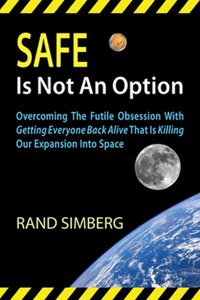A second look: Safe Is Not An Optionby Michael Fodroci
|
| Simberg correctly notes that American culture is far less risk-tolerant than it once was. He also gives a nod to purpose as a reason for accepting more risk. |
He begins by walking us through the hazards of exploration, starting with Magellan, and then discusses the early days of the Space Age. He recites a veritable litany of NASA disasters, which hardly bolsters his argument that we are obsessed with safety. He devotes a chapter to the “irrational” approach to International Space Station (ISS) safety, and concludes by providing recommendations for space vehicle design and certification for operations beyond low Earth orbit.
Simberg correctly notes that American culture is far less risk-tolerant than it once was. He also gives a nod to purpose as a reason for accepting more risk. In war, for example, we are willing to accept far more risk than we are in peacetime. The US was willing to press on with the Apollo program after the loss of three crewmembers in the Apollo I fire because the purpose of the program was considered sufficient to justify the risk. However, after the loss of the Space Shuttle Columbia, there was much discussion regarding the risk taken during that mission simply to perform microgravity experiments in low Earth orbit. As a result, all subsequent shuttle missions, with the exception of the final Hubble Space Telescope repair mission, were directed toward completing assembly of the ISS, after which the Space Shuttle was retired.
Simberg also notes the high cost and visibility of NASA programs. Fatalities during military training exercises, while tragic, seldom see prolonged reporting, even when multiple lives and expensive hardware are lost. Due to the open nature of our programs we receive wide reporting as a matter of course. The loss of an orbiter is a major news event for months, if not years. The loss of the ISS could be the story of the century.
Some of Simberg’s observations are sound, but others strike one as far-fetched. For instance, he questions why we need a launch abort system (LAS) for future crewed space vehicles, and asserts that this mitigates only a fraction of the total risk associated with only one mission phase. While Simberg may be technically correct, humans are not robots, nor are we Vulcans, operating purely on logic. Individuals flying on private carriers are, of course, free to accept whatever risks they mutually deem acceptable, something which Simberg spends considerable time on, but which I believe to be a red herring. The exploration of the solar system will be carried out by international partnerships, not by daredevils, and they will insist on a methodical approach to risk identification and mitigation, which will almost certainly include an LAS.
| While there may be a perception that we have become more “risk averse,” I would assert that what we have become is more risk aware, particularly of those risks that spring from hubris, poor communication, and a lack of curiosity. |
He also spends an entire chapter on how NASA was ready to “abandon” the ISS after the loss of the 44P Progress cargo mission. What he omits to say is that, in all of NASA’s planning, their foremost concern was with protecting the ability to reoccupy the station. Abandoning the ISS was simply never discussed. As Frank Culbertson remarked to me once (and he was in a unique position to do so, having both been a Shuttle and ISS commander, as well as a naval aviator), “When you have a fire in an airplane, you head for the ground. When you have a fire on a ship at sea, you head for the fire.” We recognize that on the ISS we are a ship at sea, and we act accordingly. We operate in degraded modes. We perform emergency EVAs with suits that are not pristine. We are constantly engaged in a complex process of trading risks against benefits, and risks against risks.
Ultimately, Simberg fails to make his case, and there are a couple places where I think he gets it dead wrong. Although we may struggle with what exactly it signifies in terms of the likelihood of loss of crew or loss of mission, we do not give safety “an almost infinite value” in our NASA spaceflight programs, as he repeatedly alleges. Safety, cost, schedule, and functionality are routinely traded against one another. A focus on safety is both necessary and healthy in large, complex, integrated programs like ours. Simberg indulges in setting numerous strawmen alight, alleging that an excessive focus on safety is counterproductive because “spaceflight isn’t safe.” He states, “…the culture of the S&MA [safety and mission assurance] community in the space industry believes… that safe and unsafe are absolute states, rather than degrees along a continuum.” This is utter nonsense. We know that spaceflight is not safe. No one at NASA says otherwise. In fact, we know it’s downright dangerous. Our focus is on identifying, characterizing, communicating, and mitigating risk to the greatest extent practical, so that we accept risk with our eyes wide open.
In short, while there may be a perception that we have become more “risk averse,” I would assert that what we have become is more risk aware, particularly of those risks that spring from hubris, poor communication, and a lack of curiosity. Rand Simberg may have a point, but he loses his way in trying to make it.
